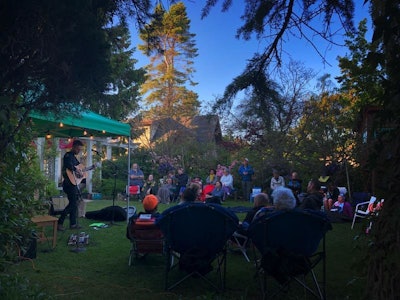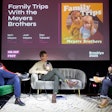
Co-founded in 2017 by artist Dan Mangan and music industry pro Laura Simpson, Side Door has been dubbed “Tinder for musicians,” allowing artists and venues to connect directly with each other to present live shows in unique places like bookstores, warehouses, coffee shops, restaurants, backyards and even a surf camp in Sri Lanka, along with virtual spaces.
“Agents, labels, promoters and managers curate the funnel to decide who has access to the very finite amount of venues,” explained Mangan, a JUNO award-winning recording artist and songwriter, about his decision to start the platform, which currently boasts a little over 2,000 spaces around the globe.
“We’re trying to turn that funnel into a sieve where artists can have a one-to-one relationship with a larger pool of performance spaces all over the world. When I was getting going as an artist, I found that playing to 40 people in a living room was far more lucrative and enjoyable than playing to those same 40 people in a club. It’s a win for artists, and it’s a win for audiences.”
The Halifax, Nova Scotia-based platform recently teamed up with SXSW organizers to present “Side Door to SXSW,” working with artists to set up shows en route to Austin for this year's festival, including pairing them with photographers and videographers at each tour stop in order to capture content and help build buzz. The tour will culminate with a showcase on March 18 at the Drafting Room. Mangan is also slated to discuss alternative venue spaces during a SXSW panel.
The tour kicked off this past Sunday in Troy, N.Y., with rock band Status-NonStatus. Hosts and venues across the country in states such as New Mexico, Louisiana, Iowa, Pennsylvania, Ohio, Tennessee, Georgia, Oklahoma and Texas were encouraged to sign up to be a part of it.
 The platform recently teamed up with SXSW organizers to present “Side Door to SXSW,” working with artists to set up shows en route to Austin for this year's festival.Screenshot: Courtesy of Side Door
The platform recently teamed up with SXSW organizers to present “Side Door to SXSW,” working with artists to set up shows en route to Austin for this year's festival.Screenshot: Courtesy of Side Door
The platform pays out the show’s stakeholders based on their mutually agreed upon split of the revenue, with Side Door keeping 10% of net revenue from the shows, after taxes and P.R.O. remittance.
While Side Door was initially designed to promote in-person performances, when the pandemic hit, the company pivoted to online shows, building a secure ticketing portal for Zoom, which is known as the “interactive” option, Mangan explained, then eventually creating a more traditional ticketing portal for livestreaming with chat and tipping features, referred to as the platform’s Broadcast option.
In an effort to support the return of live entertainment, the platform also launched “Back To Live,” a subsidy program for IRL and virtual shows. Through the program, hosts and artists were able to apply for financial support to offset the costs of a performance booked on the platform.
“We did our best to recreate the feeling of an in-person Side Door show online, focusing largely on community building and fleeting, visceral direct connection,” he said. “It’s incredible to see into 1,000 homes at once while [Australian singer and songwriter] Vance Joy plays from his living room. One time, a young woman was even proposed to in the middle of a song—spotlit for all to see.”



















